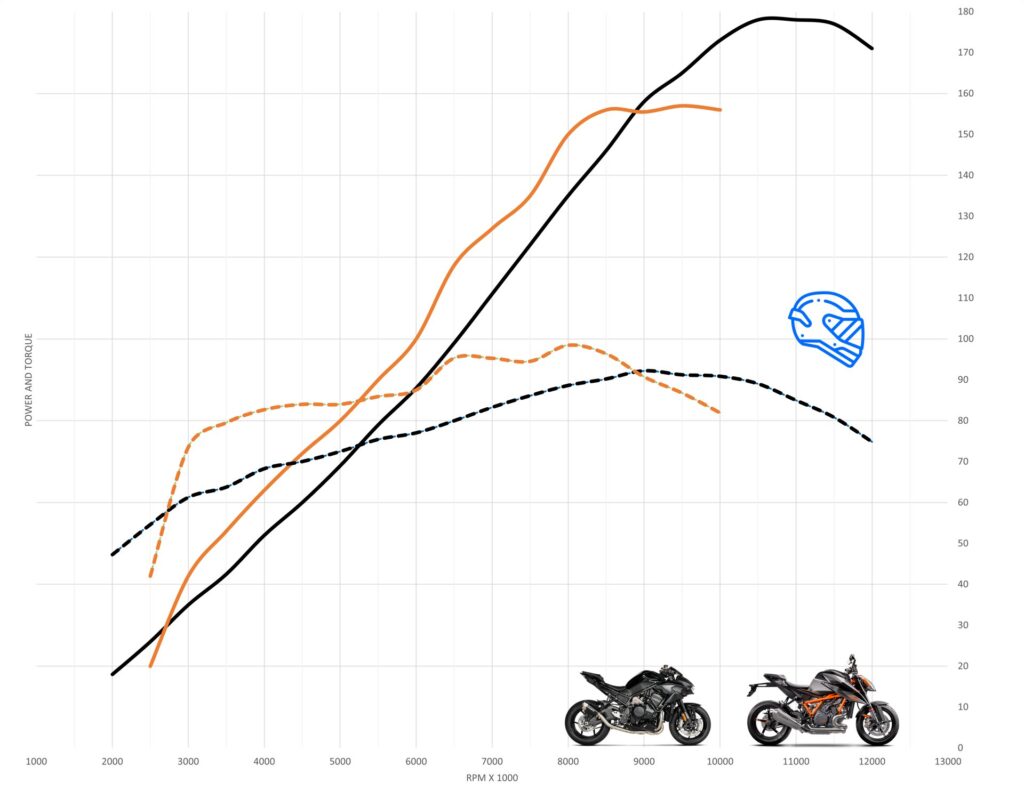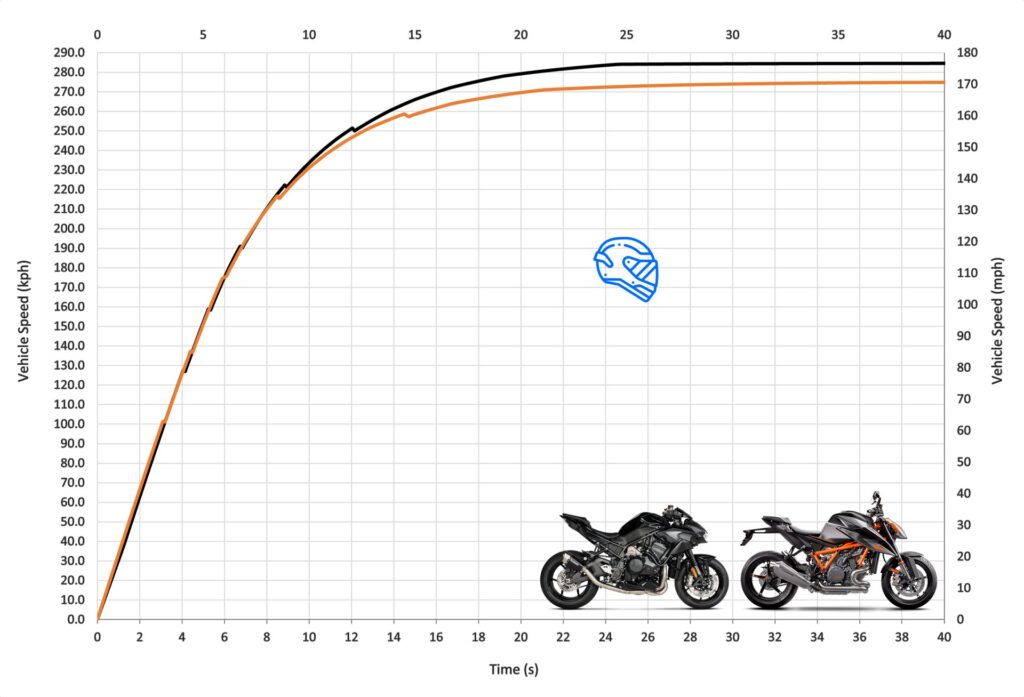Both the KTM 1290 Super Duke R and the Kawasaki Z H2 fight it out in the super heavyweight Hyper-naked class.
Each motorcycle offers exceptional power and acceleration that rival even some of the best Superbikes. Let’s look at how their engines and straight line performance stack up.

| Power/Torque | Z H2 | Duke R |
| Power | 178hp @ 10,500 rpm | 158hp @ 13,500 rpm |
| Torque | 92 ft/lb @ 9000 rpm | 99 ft/lb @ 8000 rpm |
Z H2 vs 1290 Super Duke R Dyno Curve
Monster horsepower and torque are produced by both motorcycles. The Kawasaki Z H2 has the outright horsepower advantage putting down 178 horsepower at 10,500 rpm from the supercharged 998 cc inline-four engine.
The KTM while down a fair bit at ‘only’ 158 horsepower is not to be frowned upon. That’s because this engine is still a Godzilla of a powerhouse by any standard.
The KTM engine has the advantage when it comes to peak torque almost making 100 ft/lb at the wheels with the Z H2 still hitting extremely hard with 92 ft/lb.
Both engines offer similar outright performance with the main difference being the KTM offers a more condensed and explosive delivery.
This is due it to making more torque throughout the rpm range while having gearing that is suited to the strengths of its 1300 cc engine.
Also, that kick at 6000 rpm provided by the KTM is noticed on the road with a nice surge of what already is intense acceleration.
This is not to say that the Z H2 is not ‘explosive’, far from it though it is a very linear and consistent and extremely urgent build-up of power that quite literally is overwhelming to say the least!

Z H2 vs 1290 Super Duke R Thrust Curve
The above thrust curve shows acceleration in Gs for each gear plotted against speed comparing both motorcycles.
This graph takes into consideration the torque at the rear wheel, the gear ratios, and the weight of each motorcycle. Wind resistance is not calculated.
So, while a great representation of the real-world thrust/acceleration produced by both motorcycles in each gear, if wind resistance was taken into consideration, it would look slightly different and in favour of the Z H2.
If aerodynamics were the same for both motorcycles the motorcycle with more peak power would show slightly more G’s increasing linearly as the speed rose.
If you look at the acceleration curve you will see that the Z H2 accelerates a little harder than the 1290 Super Duke from around 140-150 mph onward though the above thrust curve shows both motorcycles making similar thrust from those speeds onward which would suggest that if aero were the same, they would accelerate more-or-less the same.
The 1290 shows similar thrust as the Z H2 from 130 mph onward simply because it is 30-40 kgs lighter but as speed increases weight becomes much less of a factor to accelerate and power becomes more important to overcome wind resistance assuming aerodynamics are the same for both.
As the above graph does not take wind resistance into consideration it shows the 1290 is a little more capable at higher speeds than it really is in the real world.
Regardless of what the above graph shows, for the most part, what we can learn is that the KTM monsters the Z H2 in first gear and in second gear it almost matches the thrust/acceleration of the first gear of the Z H2. It is a similar story for third gear.
Z H2 vs Super Duke R speeds in each gear
| Speed at 5000 rpm | Z H2 | Super Duke R |
| 1st Gear | 31.4 mph | 30.3 mph |
| 2nd Gear | 40.3 mph | 41.4 mph |
| 3rd Gear | 49.1 mph | 53 mph |
| 4th Gear | 56 mph | 65.5 mph |
| 5th Gear | 62.5 mph | 78.5 mph |
| 6th Gear | 68.2 mph | 91.8 mph |
While the Super Duke’s first gear massively dominates the first gear of the Z H2 it is an advantage that cannot be put to any good use.
This is true because there is too much available acceleration meaning KTM will just flip if you ask for all of it at once.
Even the Z H2’s first gear thrust while much less than the KTM 1290 Super Duke R can also not be fully capitalized upon.
If you ask for all of it the bike will also flip.
It’s from third gear onward for the KTM and from second gear onward for the Z H2 that we are more interested in.
The KTM provides more acceleration if comparing third and fourth gear at almost any speed, other than from below 30 mph in third gear and below 35 mph in fourth gear.
This is where the KTM is ‘chuggy’ and the Z H2 will drive cleanly and is much more trackable.
In the real world from any kind of roll-on, if we exclude fifth and sixth gear for both motorcycles, the ZH2 will need a gear lower than the 1290 Super Duke R.
If not the 1290 Super Duke will jump ahead but will have to change up a little earlier as the Z H2 has a higher theoretical top speed in the first four gears.
In fifth and sixth gear, things even up a little and both motorcycles offer very similar thrust.
The KTM having a slight advantage early on in the speed range using fifth and sixth gears with them both trading blows in the upper end of fifth.
In sixth gear from about 90 mph onward the ZH H2 has a slight advantage. However in the real world and if taking wind resistance into consideration the ZH 2 would have the slight edge.
You can see the in-gear acceleration times below.
Z H2 vs 1290 Super Duke R roll-on acceleration
| Gear | 3rd | 4th | 5th | 6th | ||||
| MPH | Duke | Z H2 | Duke | Z H2 | Duke | Z H2 | Duke | Z H2 |
| 60-80 | 1.08 | 1.22 | 1.45 | 1.60 | 1.84 | 1.96 | 2.34 | 2.38 |
| 60-90 | 1.63 | 1.81 | 2.16 | 2.38 | 2.83 | 2.94 | 3.58 | 3.58 |
| 60-100 | 2.21 | 2.45 | 2.88 | 3.14 | 3.85 | 3.90 | 4.92 | 4.82 |
| 60-110 | 3.01 | 3.04 | 3.62 | 3.91 | 4.86 | 4.87 | 6.38 | 6.08 |
| 60-120 | N/A | N/A | 4.43 | 4.73 | 5.93 | 5.87 | 7.96 | 7.38 |
| 60-130 | N/A | N/A | 5.42 | 5.66 | 7.12 | 6.94 | 9.60 | 8.75 |
| 60-140 | N/A | N/A | N/A | N/A | 8.43 | 8.15 | 11.56 | 10.25 |
| 60-150 | N/A | N/A | N/A | N/A | 10.24 | 9.65 | 14.06 | 12.02 |
| 100-150 | N/A | N/A | N/A | N/A | 6.38 | 5.75 | 9.13 | 7.19 |

The above graph takes rear wheel torque and gear ratios into consideration and does not take wind resistance into consideration.
Unlike the first thrust curve graph, it does not take the weight of the motorcycle into consideration.
So, the graph shows only the peak potential thrust of the engine as if measured in isolation. (Torque multiplied by gears only)
You can see that the Z H2 in the last third of all gears excluding first gear has more top-end thrust performance and this explains the acceleration advantage it has at higher speeds.
This is the case even if the KTM’s thrust curve is similar in the first thrust curve when the weight of both motorcycles taking into consideration.

Z H2 vs 1290 Super Duke R Acceleration
The numbers below demonstrate how close both motorcycles are, though the KTM does have the slight edge for the 0-60 mph.
The KTM 1290 manages a 0-60 mph sprint of only 2.75 seconds versus the Kawasaki Z H2’s 2.91 seconds.
Both motorcycles are severely hindered by wheelies with the largest factor coming down to rider skill.
Itonly when both motorcycles are in second gear that the Z H2 starts to claw back slightly, managing a 0-100 mph time of 5.32 seconds and nudging the 1290 Dukes’ 5.36 seconds.
Both motorcycles with their monstrous power are still battling wheelies in second gear too if not using wheelie control.
From then on there is still extraordinarily little in it as they cross 130 mph with the gap only being a little over a tenth of a second advantage to the Z H2.
Both motorcycles cross the quarter mile in a fraction over 10 seconds with under a tenth of a second splitting them.
The Z H2 has a slight terminal velocity speed advantage of 2 mph with a time of 10.13 seconds at 146 mph, closely followed by the KTM only a couple of bike lengths behind with an impressive time of 10.21 seconds at 144 mph.
The gap remains similar up to around 150 mph.
The Z H2 only slightly pulling harder but in the end, the Z H2 finally asserts itself from then on and ultimately starts to walk the 1290 from 160 mph onward.
The Kawasai Z H2 eventually hits a top speed of 176.8 mph against the 1290 Super Duke R’s 170 mph top speed.
In terms of outright acceleration through the gears, both motorcycles are very close and pretty much trade blows all the way up to 150 mph.
In the real world from a dig, the difference will primarily come down to rider weight and skill though.
Once moving, if both riders are caught napping and perhaps not in the ideal gear the KTM would have the initial advantage on the roll in most scenarios but eventually, the Z H2 will chase down and pass the KTM if both were to go at it for long enough.
In reality, both motorcycles are too close to worry about one being faster or slower than the other.
Both motorcycles offer Superbike matching and beating performance.
| Speed | Z H2 | KTM |
| 0-10 mph | 0.96 | 0.4 |
| 0-20 mph | 0.96 | 0.9 |
| 0-30 mph | 1.445 | 1.31 |
| 0-40 mph | 1.93 | 1.73 |
| 0-50 mph | 2.43 | 2.21 |
| 0-60 mph | 2.91 | 2.75 |
| 0-70 mph | 3.45 | 3.43 |
| 0-80 mph | 4.09 | 4.11 |
| 0-90 mph | 4.63 | 4.78 |
| 0-100 mph | 5.32 | 5.36 |
| 0-110 mph | 5.97 | 6.15 |
| 0-120 mph | 6.88 | 6.96 |
| 0-130 mph | 7.81 | 7.95 |
| 0-140 mph | 9.16 | 9.43 |
| 0-150 mph | 10.67 | 11.25 |
| 0-160 mph | 13.2 | 14.19 |
| 0-170 mph | 17.14 | 28 |
| 60-130 mph | 4.88 | 5 |
| 100-150 mph | 5.34 | 5.88 |
| SS/QM | 10.13 @146 mph | 10.21 @144 mph |
| SS/KM | 18.40 @172 mph | 18.67 @166 mph |
| SS/Mile | 26.07 @176 mph | 26.60 @169 mph |
| Top Speed | 176.8 mph | 170 mph |
















